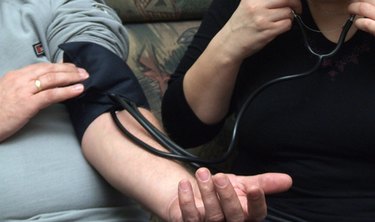
Blood pressure readings are most often taken in the upper arm, between the elbow and the shoulder. For some patients, obtaining a blood pressure reading in this area isn’t possible, most often due to the size of the arm. Sometimes medical professionals take blood pressure readings on the forearm instead of the upper arm in these patients. A study published by the New York State Nurses Association found that blood pressure readings taken in the forearm were significantly higher than readings taken in the upper arm; therefore forearm readings are not as accurate.
Step 1
Measure your forearm at the widest point closest to the elbow, using a cloth measuring tape. Blood pressure cuffs are available in different sizes. Although forearm measurements are often taken because other cuffs won’t fit the upper arm, the forearm is often much smaller and can accommodate a smaller cuff. It is still important to use the right size for the most accurate reading and best fit. If your arm circumference is 9 to 13 inches, you should purchase and use a standard adult cuff. If your arm circumference is 13 to 17 inches, you need a large cuff. If your cuff is improperly sized, you will not be able to place the cuff on your arm properly.
Video of the Day
Step 2
Slide the blood pressure cuff onto your arm. Apply the cuff to a bare arm. If you need to roll up your sleeve, the sleeve should not apply extra pressure to the arm, so change into a short sleeve shirt if needed. Most blood pressure cuffs have a marker that indicates where the cuff should be placed in relation to the brachial artery. Note that when taking blood pressure on the forearm, the cuff will have to be reversed so that the marker is at the top, since the brachial artery is located in the elbow.
Step 3
Position the cuff so that the edge of cuff with the brachial marker is within an inch of your elbow. Many cuffs are held together with a D-ring that makes it easier to put the cuff on yourself. If the cuff does not have a D-ring, make sure that the cuff is even all the way around.
Step 4
Secure the cuff by pulling it snug, but not tight. You should be able to place one finger underneath the cuff. Readjust the cuff if needed if it is too tight or too loose.
Things You'll Need
Blood pressure monitoring device
Tape measure
Video of the Day
Is this an emergency? If you are experiencing serious medical symptoms, please see the National Library of Medicine’s list of signs you need emergency medical attention or call 911.